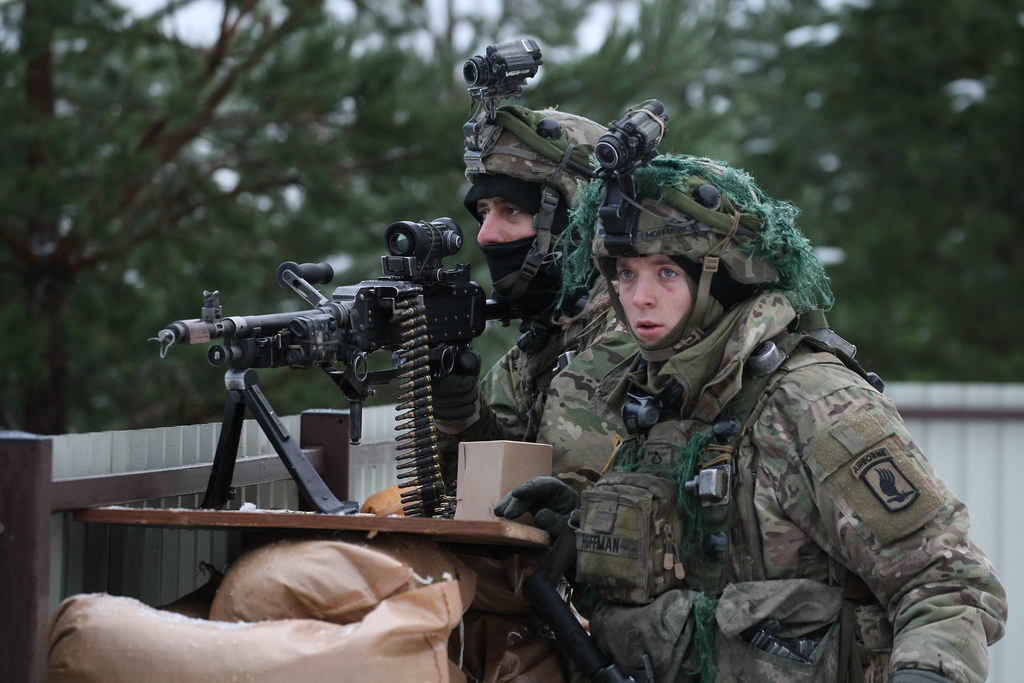NATO NRF
Decision to establish NATO Response Force (NRF) was adopted by member states during Prague Summit on 22 November 2002. NRF is a highly ready and technologically advanced multinational force that trains for wide variety of operations. Made up of land, air, maritime and Special Operations Forces components that the Alliance can deploy quickly and wherever needed, they conduct joint training to reach high combat readiness and be rapidly deployed to operations far from their permanent stations.
NRF was created as a result of transformation that happened within the Alliance, manifesting its ability to adapt to new global security situation. Latvia joined NATO Response Force in 2006.
NRF was declared fully operation during the 2006 Riga Summit, whereas in 2014 Alliance’s defence ministers agreed to establish and pilot Very High Readiness Joint Task Force. NATO also decided to increase its Response Force from 13,000 to 30,000 troops. Altogether, the enhanced NRF comprises around 40,000 troops.
After the full-scale Russian invasion of Ukraine in 2022, NATO decided to deploy NRF’s high-readiness deterrence and defence elements for the first time.
During the 2022 NATO Madrid Summit, allies approved new NATO Force Model, which will replace NRF. It will provide a larger pool of high-readiness forces, which will be pre-assigned to specific plans for the defence of Allies.
At the 2023 Vilnius Summit, NATO leaders approved a new generation of regional defence plans and also agreed to establish a new multinational and multi-domain Allied Reaction Force.
NRF consists of:
- Command control element.
The management of the NRF in a rotation order lasting 12 months since 2012 shall be carried out by one of the two operational command commands of NATO Joint Forces in Brunswick and Naples;
- Very High Readiness Joint Task Force (VJTF).
It consists of a multinational brigade with approximately 5000 troops supported by a component of maritime, air and special operations. Some elements of this unit are able to expand within two or three days;
- Initial Follow-On Forces Group (IFFG).
They are high-readiness forces that, in response to the crisis, can quickly turn out immediately behind THE VJTF. These are made up of two multinational brigades;
- Naval component.
It is based on NATO Standing Naval Maritime Groups (SNMG) and NATO Standing Naval Mine Counter Measures Groups (SNMCMG);
- Air and air-defence component;
- Special operations forces;
- Forces for protection from chemical, biological, radiological hazards and against weapons of mass destruction;
- Follow On Forces Group FFG.
Latvia in NRF:
Latvia started contributing to NRF in 2006 with Explosive Ordnance Disposal (EOD) unit, ready to deploy within 5 days notice.
|
Rotation |
Timeline |
Unit |
|
NRF 7 |
2nd half-year of 2006 |
18 soldiers (EOD) |
|
NRF 8 |
1st half-year of 2007 |
30 soldiers (MP ) |
|
NRF 10 (SNMCMG1) |
1st half-year of 2008 |
42 soldiers (Navy) |
|
NRF 11 |
2nd half year of 2008 |
52 soldiers (EOD, MP) |
|
NRF 12 (SNMCMG1) |
1st half-year of 2009 |
44 soldiers (Navy ship) |
|
NRF 14 |
1st half-year of 2010 |
3 soldiers (HQ) |
|
NRF 2012 |
01.01.-31.12.2012. |
30 soldiers (MP) |
|
NRF 2013 |
01.01.-31.12.2013. |
Navy ship |
|
NRF 2014 |
01.01.-31.12.2014. |
EOD unit, Navy ship |
|
NRF 2015 |
01.01.-31.12.2015. |
82 soldiers (MP, Navy) |
|
NRF 2016 |
01.01.-31.12.2016. |
45 soldiers (Navy ship) |
| NRF 2017 | 01.01.-31.12.2017 | In 2017, a light infantry company, a Special Task Force and a Navy ship were provided for the participation in the NRF. |
| NRF 2018 | 01.01.-31.12.2018 | In 2018, a Combat Engineer Unit, a company level sub-unit, a Special Task Force and a Navy ship have been provided for the NRF. |
| NRF 2019 | 01.01.-31.12.2019 | In 2019, a light infantry company, an engineer unit, a Special Task Force and a Navy ship have been provided for the NRF. |
| NRF 2020 | 01.01.-31.12.2020 | In 2020, a light infantry company, a Special Task Force, an engineer unit, an explosive ordnance disposal unit, a Navy ship, BALTBAT 2020 have been provided for participation in the NRF. |
| NRF 2021 | 01.01.-31.12.2021 | In 2021, a Navy ship, Infantry unit and an explosive ordnance disposal unit have been provided for participation in the NRF. |
| NRF 2022 | 01.01.-31.12.2022 | In 2022, an artillery battery, special task elements, a Navy ship, a mechanised infantry unit, an explosive ordnance disposal unit and a intelligence element have been provided for the NRF. |
| NRF 2023 | 01.01.-31.12.2023 | In 2023, an artillery battery, special task elements, a movement support element, an explosive ordnance disposal unit and an intelligence element are provided for the NRF. |

